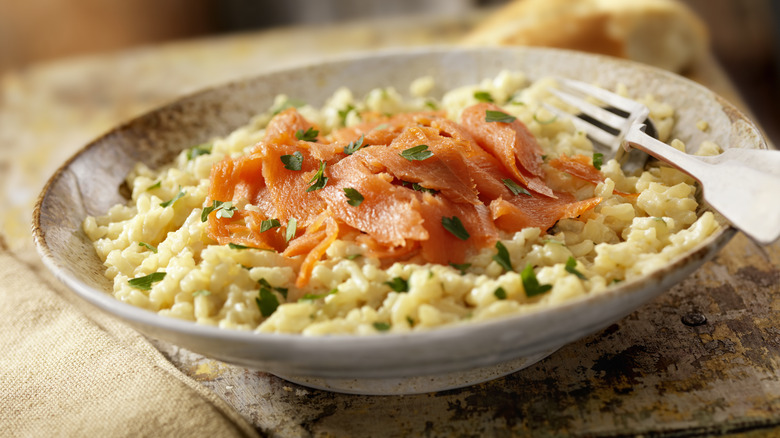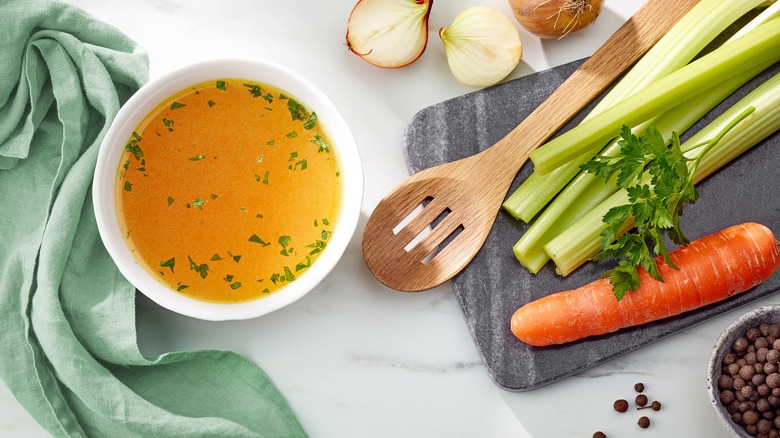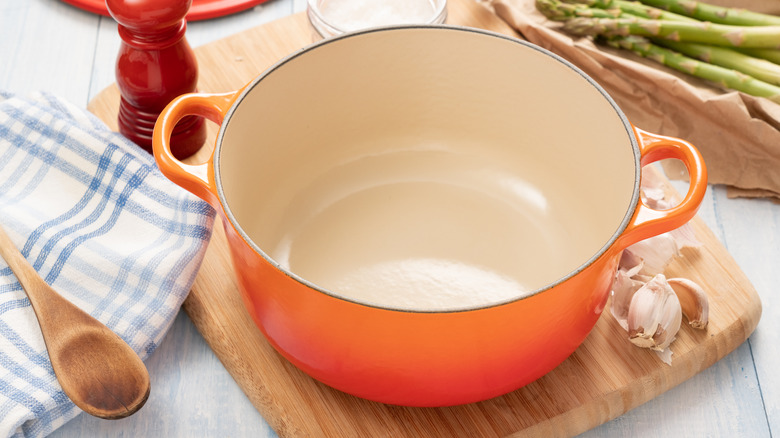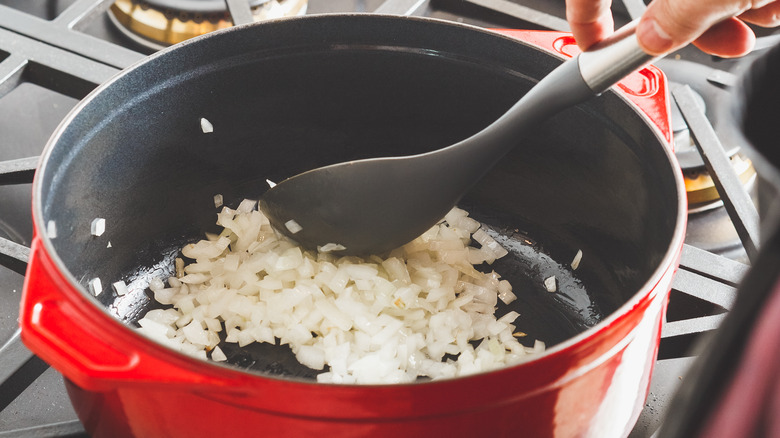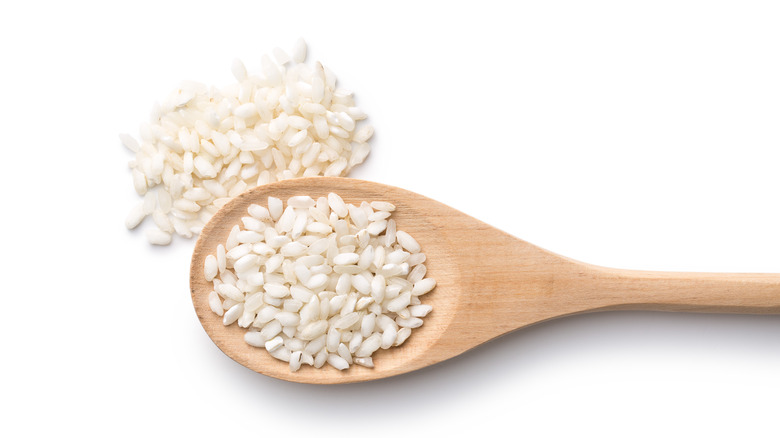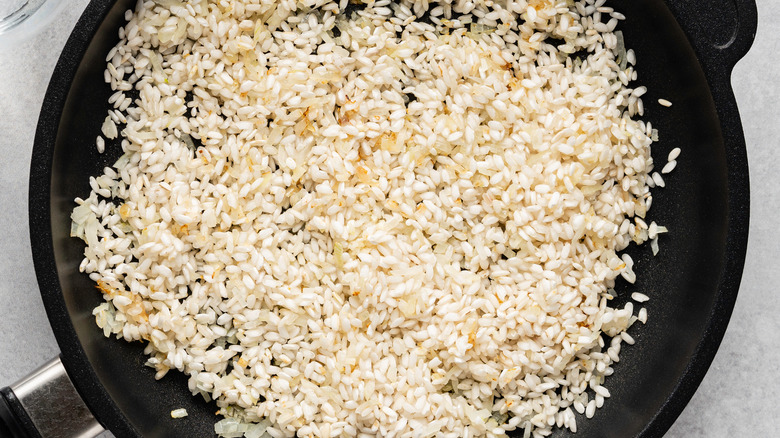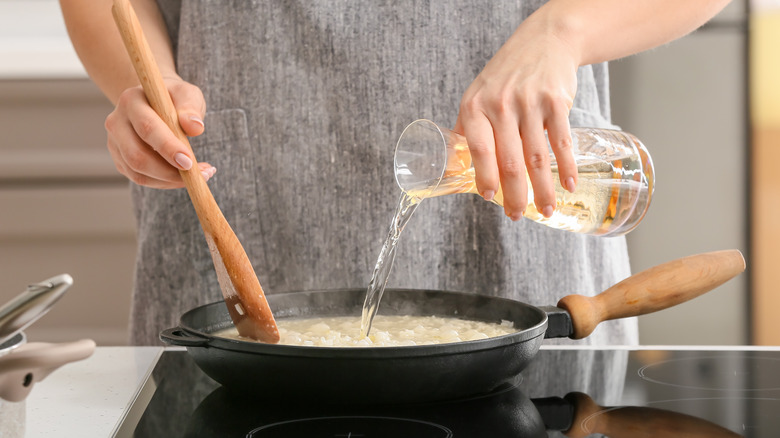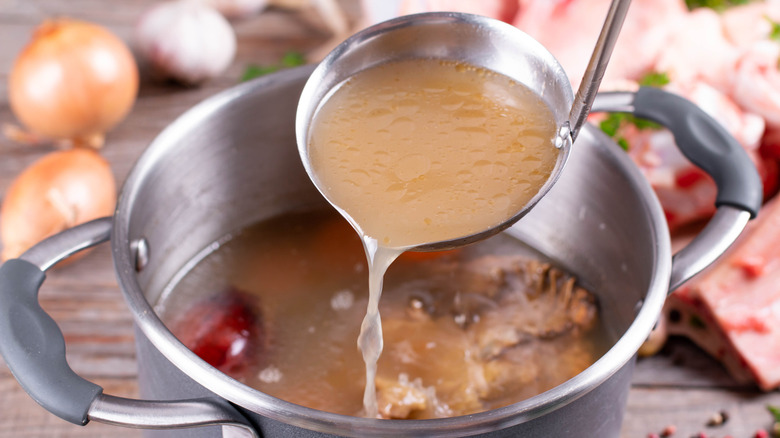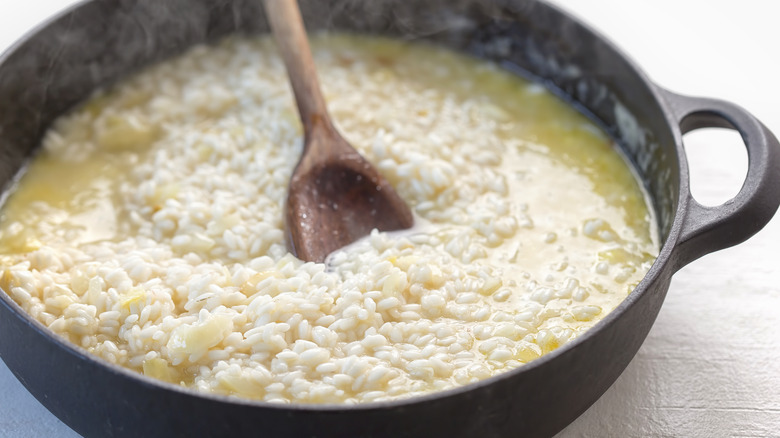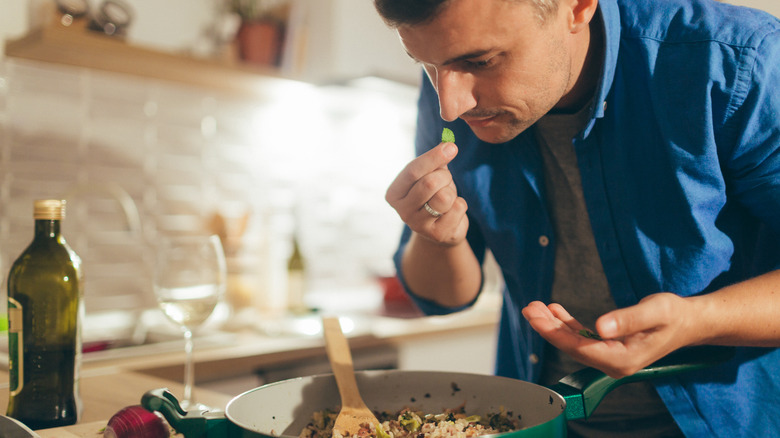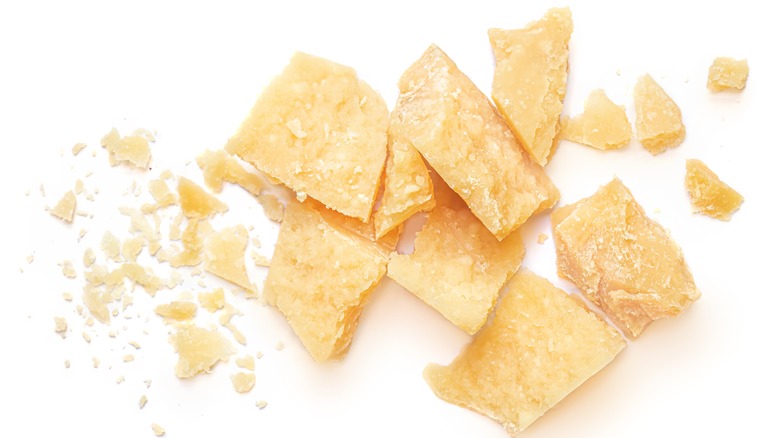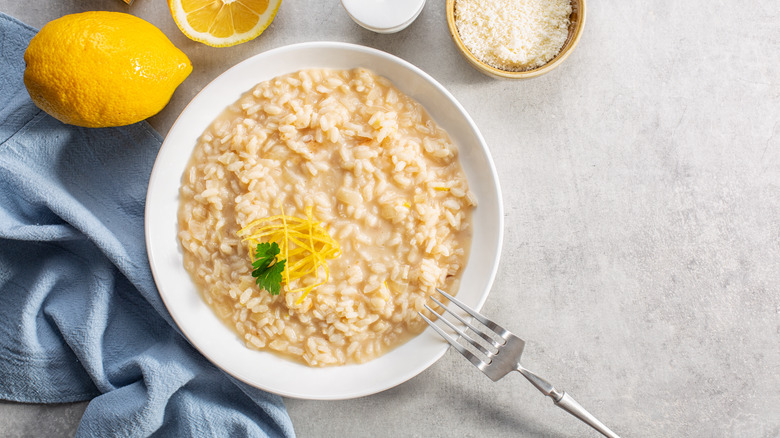Why Risotto Always Tastes Better At A Restaurant
Steamy, creamy risotto on a chilly night is the perfect comfort food. But your homemade version doesn't taste as good or feel as smooth as what they serve at a restaurant. Many home cooks have wondered what it is that professional chefs do to make humble rice taste so amazing. They must have some secret technique up their sleeve to turn those hard grains into such a delicious velvety dish, right?
To find out, we asked chef Jenna Arcidiacono, who has appeared on Food Network's "Guy's Grocery Games" and owns an authentic Italian restaurant, Amore Trattoria, in Grand Rapids, Michigan. She says that one of the key factors in making really good risotto is all about settling in. "Mostly you have to be patient and have time for risotto [...] It takes a good 30 minutes to make risotto from scratch," she says. This means that preparing this classic Italian dish will take your full attention, from start to serving, according to the restaurateur.
Of course, there are a few more considerations to keep in mind. What goes into making some of the high quality risotto you've dined on in a restaurant. Read on to find out what techniques top restaurant chefs use to elevate their risottos in addition to buckling down, getting ready to concentrate, and stretching their stirring arms.
Professional chefs use homemade stock
Stock gives risotto its flavor, so restaurant chefs work hard to use the most delicious stock possible. That stock should also match the flavor of any goodies that you plan to add later. For example, to make the beef-laden variety known as ossobuco risotto, be sure to simmer up some beef stock. And if you're planning on serving mushroom risotto, some chicken or vegetable stock should do the trick to complement the umami flavor of the mushrooms. And if you happen to be adding seafood to the mix? Shrimp stock will be perfect.
Now, you could grab a bouillon cube and dissolve it into a pot of water, but just a little bit of work and drawing on other options will make this northern Italian dish taste much better. Homemade chicken stock is one of the best ways to take risotto to the next level. It takes a little planning and prep, but stock isn't hard to make at home. After eating a rotisserie chicken, take the leftover carcass, add a quartered onion and some spices, and simmer everything for about an hour. Strain out the veggies and bones. Then, leave this stock in your freezer until the next time you decide to make risotto.
Or, consider making shrimp stock, which is easy and much faster than chicken stock. Just take the shells after cleaning some shrimp, brown them in oil, add some water, and simmer for five minutes. Using this stock means the seafood flavor will truly soak into the rice. You won't be eating rice with lumps of shellfish, but rather true shrimp risotto.
They use the right pot, spoon, and temperature
Using the right tools will help you make risotto without breaking a sweat. First, be sure to grab a wide, shallow, and heavy-bottomed pan. Thin pans can cause the rice to cook more quickly or even burn. This means that, if you're trying to make risotto in the same pot you use to boil pasta, you'll probably just end up seriously frustrated and with nothing but burned rice goo to show for your troubles. Don't worry though, as there's a variety of cookware out there that will make the process easier and result in tastier risotto.
Chef Billy Parisi says to use a large rondeau pan, which has a wide, flat bottom with plenty of surface area for cooking. What's more, the sides are higher than a frying pan but lower than that of a deep stock pot, making it easy to stir — and you'll be doing a lot of stirring. You might also consider using a Dutch oven, which is perfect for risotto since the heavy, enameled metal heats evenly and further prevents burning. The heavy lid means you can add shrimp after turning off the burner and cook the shellfish only using the residual heat of the rice and metal.
Then, there's the spoon. You may think that any kind of stirring element will do. After all, these are just glorified sticks, aren't they? Think again! Chef Gennaro Contaldo, who collaborated with celebrity chef Jamie Oliver, says you must use a wooden spoon and never a metal one. Metal spoons can break the rice grains and you may end up with mashed rice instead of risotto.
They start by sauteeing shallots or onions and garlic
To get risotto started, Arcidiacono says you should chop some onions and garlic into a fine dice, then sautee them in olive oil and butter, which is part of the traditional Italian recipe. Even if you aren't crazy about alliums, add just a little at the beginning and you'll see that your risotto becomes much more flavorful thanks to their addition.
Be sure to chop your onions very finely, as practically no one wants to feel a big chunk of onion in their mouth as they're enjoying the creamy texture of risotto. While that vegetable mix is cooking in oil, take some time to sprinkle a bit of salt and baking soda on top. This helps the veggies turn extra soft, guaranteeing they won't affect the texture of the finished dish.
How long you cook the veggies at this point is important, too. The goal is to achieve soft, translucent onion, not browned bits or even burned ones. This process should only take a few minutes. If you're planning on making a mushroom risotto, this is also the time to add the fungi. Remember to not chop these too finely, however, as they'll lose water and shrink a lot during cooking.
They don't use just any type of rice
The texture of risotto depends in large part on the variety of rice you use. First, forget using a box of minute rice. Making perfect risotto with long grain varieties, like basmati rice, is also next to impossible. Likewise, steer away from East Asian short grain rice varieties, since these tend to stick together and inhibit a smooth texture. Instead, a good risotto will consist of individual rice grains that are suspended in a creamy liquid, not sticky clumps covered in goo. Arcidiacono says that arborio or carnaroli rice produces the best results, as these varieties are little sponges that soak up liquid, growing up to three to four times their original size.
Arborio is the most common risotto rice in the United States, meaning that it should be relatively easy to find in your local supermarket. Its name comes from a town in the Italian Po River region where farmers developed the variety. It's special because it contains a high amount of amylopectin, a starch that seeps out of the grains and into the stock while you stir, turning the liquid creamy. The superfino label on a rice bag indicates the high starch content of the grains, so pick that kind if you spot it.
Knowing how much rice to make per person is also important. A little over two ounces (or a heaping quarter cup) will do nicely. Chef Contaldo says to measure out a scooped handful per diner.
They toast the rice
You simply have to toast risotto rice before you add any liquid to the pan, in a key step that Italian chefs call tostatura. Arcidiacono says that she pours her risotto rice in with the vegetable base and cooks it for a bit to achieve this goal.
Here's how why this works: as you toast them, the grains of rice get covered in oil which will help them maintain their shape as they cook later. It also means they'll absorb liquid fairly slowly, resulting in more tender grains and plenty of creamy starch in the final dish. Most importantly, toasting adds a nutty layer of flavor to restaurant risotto that just may be what your homemade version has been lacking.
The idea of toasting rice may seem strange at first, but it's a relatively easy and quick way to boost flavor and texture. Use medium heat and keep the grains moving to prevent burning. Plan on a short cook time of about 30 seconds to one minute, as that's just enough time to coat each grain with fat and stir once or twice. You'll know your rice is sufficiently toasted when it looks translucent and smells a little nutty.
They add wine
Close your eyes and imagine the sound that happens when you pour a portion of cool wine over a hot pan that's already loaded with toasted risotto rice and vegetables. That hiss and the quick release of steam is why many Italian chefs poetically call this part of the recipe the sigh.
There's no strictly right or wrong wine to use here — just make sure it's a good one for drinking and you'll be fine. You can make strategic wine choices, however, as the kind of wine you choose will depend on the other ingredients. For example, a white wine will help to bring out the more subtle taste of seafood while red wines are fantastic in heartier applications like beet risotto.
Since wine is also the first liquid you'll likely add in the risotto process, this is when the stirring begins. Grab your wooden spoon and make big, slow, graceful circles around the pan until most of the wine has either been absorbed by the starchy grains or evaporated.
They add the stock little by little
This is yet another step in the risotto process that deserves care and patience. Arcidiacono says she adds stock to her risotto slowly, giving the sponge-like rice a chance to soak everything up. It sounds easy enough, but to get this done properly, you will have think about your setup ahead of time. First, keep a covered pot with stock on low heat on a back burner, as using hot liquid will help the dish cook faster. This pot should have more than five cups of liquid for every two cups of rice. Make sure you have extra so you don't run out before finishing your risotto and can use a ladelful at the end to achieve the perfect creamy texture.
Then, use a ladle to carry the stock to your risotto and to act as a measuring tool. Add one large (or two small) ladlefuls at a time to help the rice cook evenly. Add more liquid when you see that the rice has absorbed most of what was in the pan.
Don't try to hurry things by adding more liquid fewer times. Adding the stock slowly can get tedious and stirring may tire your arm. Some recipes provide a workaround to add most of the liquid at once by employing a pressure cooker risotto or baking the risotto. These methods work, but if your dream is to achieve restaurant-quality risotto, then stick with a stovetop method that uses a wooden spoon and ladle.
They know stirring is the secret
Risotto is not a dish you can leave on the stove and walk away, as it needs your constant attention. Of course, stirring for that amount of time isn't easy because it requires a certain mental peace. Think of this recipe as an opportunity for meditation and prepare yourself. Scoot a high stool next to the stove if you don't want to be on your feet that long. Set out a glass of wine to sip, ask your partner to chat with you, or put on some music.
This step is fundamental because continually moving the rice grains around helps release the starch and gives risotto its silky smooth texture. There's another reason to keep your wooden spoon moving. Rice burns easily, especially since you're adding the liquid so slowly. With that in mind, make sure you're scraping the sides of the pan with your spoon so no grains stick there. Careful — if you stop stirring, the rice can also stick to the bottom and your entire risotto will end up scorched. No one wants to clean that up or deal with the stink.
Keep the cooking temperature in mind, too, and set your burner at low to medium heat. Trying to hurry your risotto along on high means that only the outer part of the grains will soften while the insides remain hard.
They've made it a thousand times
People get good at the things they practice a lot. A chef in a restaurant with risotto on the menu has probably made the dish more times than they can count. This experience gives them an advantage at every stage of the preparation because they know just how it should look, smell and feel. There's one stage in particular where this knowledge comes in especially handy: knowing when to stop.
Arcidiacono says you'll know your risotto is perfectly cooked when you can cut into a single grain of rice without seeing any white. At the same time, you should still be able to see the individual kernels of rice, so don't cook it so long that your rice turns completely to mush. A good risotto isn't too soupy, but it isn't dry either. That's hard to get right.
In short, it'll be hard for a first-timer to know if it's done, so a taste test can be helpful here. Ultimately, you'll probably need to make risotto multiple times before you get it just right and it tastes like it came from your favorite Italian restaurant.
They add butter, cheese, and protein at the end
When your risotto is cooked, stirring in some butter and cheese will give it a special shine, says Arcidiacono. Cheese always goes in at the end, in a final stage known as mantecare (to mix) in Italy.
Every chef has a different take on this final stage. Some add heavy whipping cream and parmesan to give their risotto the finishing touch. Others add a whole stick of butter and pecorino. Either way, butter and cheese mean that your risotto can become tremendously delicious.
Other ingredients can come in at the end, too, like fresh chopped tomatoes and basil leaves. And if you're making shrimp risotto, this is the right time to add raw shrimp. Even though the heat is off, leaving the shrimp in the hot rice for a few minutes will cook them through perfectly. For chicken or ossbuco risotto, you'll need to cook the meat separately and then mix it in at this time. That way you ensure your protein doesn't get chewy.
The way they serve it
Presentation is one of the great pleasures of eating in a restaurant. Chefs have a way of arranging a plate just so, giving food an appearance that's just as delicious as its taste. With risotto, that's not always easy, since this dish can look a bit like slop. Still, chefs have their way.
Arcidiacono says, first and foremost, to serve risotto immediately, as this is not food that you can prepare ahead of time and reheat. After just a few minutes, it will have turned into an unappealing, gelatinous blob. To avoid this, serve risotto in pre-warmed ceramic bowls so it stays creamy until you've finished it.
Chef Joshua Weissman puts a ladleful of risotto in the middle of a plate and taps the underside of the dish so that the custard-like rice relaxes into a perfect circle. Then, he tops it off with a bit of parmesan cheese and balsamic vinegar.
